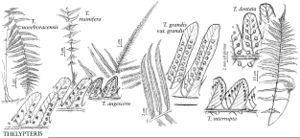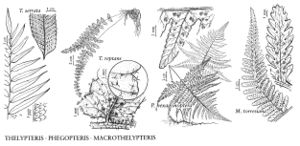Thelypteris
Icon. Pl. ed. Keller, 3 45, plates 11, 13. 1763.
Stems long-creeping to ascending to erect, 1.5–12 mm or more diam. Blades 1-pinnate to pinnate-pinnatifid, rarely 2-pinnate, proximal pinnae reduced or not, apex commonly gradually reduced, infrequently abruptly reduced and pinnalike; pinnae entire to deeply pinnatifid, sessile or short-stalked; costae grooved adaxially; buds absent or uncommonly present in axils of pinnae; veins free to regularly anastomosing, commonly simple (1-forked in a few species, e.g., Thelypteris palustris) and reaching margin; indument various abaxially, often of simple or branched hairs on blades, rachises and costae with or usually without scales. Sori round, oblong, or elongate along veins, commonly medial to supramedial; indusia round-reniform, large (ca. 1 mm diam.) and persistent or sometimes small (less than 0.3 mm diam.), occasionally ephemeral, sometimes absent; sporangial capsules glabrous or occasionally hairy. x = 27, 29, 31, 32, 33, 34, 35, 36.
Distribution
Nearly worldwide
Discussion
In the broadest sense, Thelypteris is a very large and complex genus of about 900 species and constitutes the only genus in the family. It has been divided into ca. 30 genera by R. E. Holttum (1971, 1982); these are treated as subgenera and/or sections by various workers. In the treatment adopted here, the genus is broadly circumscribed but excludes the small segregate genera Phegopteris and Macrothelypteris, two of the most distinctive elements. The subgroups of Thelypteris (treated as genera by some workers) are indicated in the key to species and by their subgeneric names preceding the treatment of species groups. The name to be used if a narrowly circumscribed segregate genus is adopted is included in the synonymy.
Species ca. 875 (21 in the flora).
Selected References
Lower Taxa
Key
| 1 | Pinnae entire or merely serrate; veins regularly united in pairs to form parallel rows of more than 5 areoles between costa and pinna margin, areoles each with single excurrent, usually free veinlet (subg. Meniscium). | > 2 |
| 1 | Pinnae shallowly to deeply lobed; veins free, connivent at sinuses, or 1-2 pairs between primary veins uniting to form common vein extending to sinus. | > 3 |
| 2 | Pinna margins hooked-serrate. | Thelypteris serrata |
| 2 | Pinna margins entire to undulate or crenulate. | Thelypteris reticulata |
| 3 | Stellate and/or forked hairs present, especially on scales at apex of stems, on rachises, especially in adaxial grooves, and often on other parts of blades (subg. Goniopteris). | > 4 |
| 3 | Stellate or forked hairs absent. | > 6 |
| 4 | Blades mostly 15-25 cm wide, proximal pinnae not reduced, blade abruptly narrowed distally, apical pinna similar to lateral pinnae; pinnae usually 6-8 pairs. | Thelypteris tetragona |
| 4 | Blades mostly 2-8(-10) cm wide, with or without reduced proximal pinnae, blade gradually narrowed distally to pinnatifid apex, apical pinna not similar to lateral pinnae; pinnae 6-25(-30) pairs. | > 5 |
| 5 | Pinnae with acute lobes; blade hairs subsessile, stellate; blades erect, not rooting at apex. | Thelypteris sclerophylla |
| 5 | Pinnae entire or with shallow, rounded lobes; blade hairs stalked, stellate, mixed with needlelike hairs; blades commonly arching or pendent and rooting at apex. | Thelypteris reptans |
| 6 | Sori elongate; sporangia minutely hairy (subg. Stegnogramma). | Thelypteris pilosa var. alabamensis |
| 6 | Sori round or slightly oblong; sporangia glabrous. | > 7 |
| 7 | Blades with all veins extending to margin above sinus; proximal pinnae greatly reduced or not. | > 8 |
| 7 | Blades with at least some basal veins extending to, connivent at, or united below sinus; proximal pinnae usually not reduced (subg. Cyclosorus), or if reduced, then veins united below sinus. | > 13 |
| 8 | Proximal pinnae not reduced or only slightly so, not much shorter than middle pinnae. | > 9 |
| 8 | Proximal pinnae greatly reduced, much shorter than middle pinnae. | > 10 |
| 9 | Segment veins often forked; blades lacking glands; abaxial surface of costae with tan, ovate scales (subg. Thelypteris). | Thelypteris palustris var. pubescens |
| 9 | Segment veins not forked; blades bearing sessile glands abaxially; costae lacking scales (subg. Parathelypteris). | Thelypteris simulata |
| 10 | Petioles (and often rachises and costae) with persistent tan to straw-colored, linear-lanceolate scales abaxially (subg. Lastrea). | Thelypteris quelpaertensis |
| 10 | Petioles persistently scaly only toward base, rachises and costae lacking scales abaxially. | > 11 |
| 11 | Stems erect, trunklike with age; leaves evergreen; blades abaxially with dense reddish, hemispheric, sessile glands (subg. Amauropelta). | Thelypteris resinifera |
| 11 | Stems creeping (apices sometimes upturned with leaves clustered); leaves dying back in winter; blades glandular or not abaxially (subg. Parathelypteris). | > 12 |
| 12 | Costae conspicuously hairy abaxially, hairs ca. 1 mm; blades abaxially lacking glands or with sparse, mostly sessile glands. | Thelypteris noveboracensis |
| 12 | Costae glabrous or sparsely hairy abaxially, hairs 0.2-0.7 mm; blades abaxially with numerous yellow to orange, mostly short-stipitate glands. | Thelypteris nevadensis |
| 13 | Basal veins of adjacent segments united below sinus, excurrent vein leading toward sinus. | > 14 |
| 13 | Basal veins of adjacent segments free, or connivent at sinuses. | > 16 |
| 14 | Stems long-creeping; costae with tan ovate scales abaxially; veins, costules, and costae adaxially glabrous or sparsely hairy with hairs less than 0.2 mm. | Thelypteris interrupta |
| 14 | Stems short-creeping or suberect; costae without scales abaxially; veins, costules, and costae moderately to rather densely hairy adaxially with hairs greater than 0.3 mm. | > 15 |
| 15 | Costae with predominantly short hairs uniform in length (less than 0.2 mm and often less than 0.1 mm) on abaxial surface; excurrent veins mostly greater than 2 mm; petioles purplish; leaves with usually more than 2 pairs of greatly reduced proximal pinnae. | Thelypteris dentata |
| 15 | Costae with most hairs greater than 0.3 mm (some exceeding 0.5 mm) on abaxial surface, hairs not uniform; excurrent veins less than 2 mm; petioles straw-colored; leaves with 0-2 pairs of slightly reduced proximal pinnae. | Thelypteris hispidula var. versicolor |
| 16 | Stems suberect to erect; scales at base of petioles ovate, glabrous. | Thelypteris patens var. patens |
| 16 | Stems long- to short-creeping; scales at base of petioles lanceolate, usually hairy. | > 17 |
| 17 | Costules and veins adaxially with at least a few rather stout hairs mostly longer than 0.3 mm; blades adaxially often rather glandular; scales absent on abaxial surface of rachises and costae of mature leaves. | > 18 |
| 17 | Costules and veins adaxially glabrous; blades adaxially lacking glands; a few scales often persistent on rachises and/or costae abaxially. | > 19 |
| 18 | Proximal pinnae (1-2 pairs) somewhat reduced; stems short-creeping, sometimes appearing suberect; venation variable, even on same leaf, veins united and giving rise to short-excurrent vein or veins connivent at sinus; blades adaxially often somewhat hairy; veins adaxially always with stout hairs, many longer than 0.4 mm. | Thelypteris hispidula var. versicolor |
| 18 | Proximal pinnae usually not at all reduced; stems short- to long-creeping; veins connivent at sinus or distal vein of each pair meeting margin slightly above sinus; blades glabrous or sparsely hairy adaxially; veins adaxially with or without stout hairs. | Thelypteris kunthii |
| 19 | Apical portion of blades somewhat similar to lateral pinnae; pinnae less than 2 cm wide. | Thelypteris augescens |
| 19 | Apical portion of blades ± attenuated, different from lateral pinnae; pinnae 0.8-4.8 cm wide. | > 20 |
| 20 | Basal segments of pinnae near base of blade slightly elongate and parallel to rachis; costae abaxially lacking scales or scales sparse. | Thelypteris ovata |
| 20 | Basal segments of pinnae near base of blade not elongate and not parallel to rachis, or only those facing apex of rachis elongate and enlarged; costae abaxially bearing few to many scales. | > 21 |
| 21 | Pinnae more than 2 cm wide; costae abaxially with hairs ca. 0.1 mm. | Thelypteris grandis var. grandis |
| 21 | Pinnae less than 2 cm wide; costae abaxially with hairs at least 0.2 mm. | Thelypteris puberula var. sonorensis |

